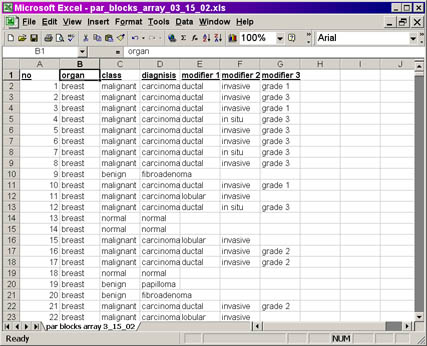Lookup File layout -- screenshot

Click on the image for a larger view of the picture.
- The lookup table should contain a header at Row 1.
- Unique case numbers should be located in column A.
- Columns B-F can contain additional information and will be included in the NAME column of the output file (which will correspond to the descriptors under Treeview). These descriptors can be diagnostic features (tumor grade, etc., as in this example) but can also contain clinical data such as follow-ups, etc.
- Information in Column G will not be included in the NAME
column of the output file. This was because we hadn't found it
necessary to include tumor grades in our datasets. However, if it
is desired that such information be included, the workaround is to
simply include all the remaining information that you want
appearing in the TreeView or K-M output files in the first two
modifier columns (E and F). An easy way to do this in Excel is to
concatenate data from two or more columns into a single column,
while adding a separator such as "|". For example, if your
spreadsheet appears as follows:
Row Column A Column B Column C 1 Descriptor_1 Descriptor_2 (blank)
Insert the following formula in the blank cell in Column C:
=A1&" | "&B1
The output in cell C1 would show as such:
Descriptor_1 | Descriptor_2
- A pipe ("|") will appear between the information contained within each column, in the output file.
- Any additional information beyond Columns A-F will not be included in the output file.
Please refer to the screenshot for an example of the layout.